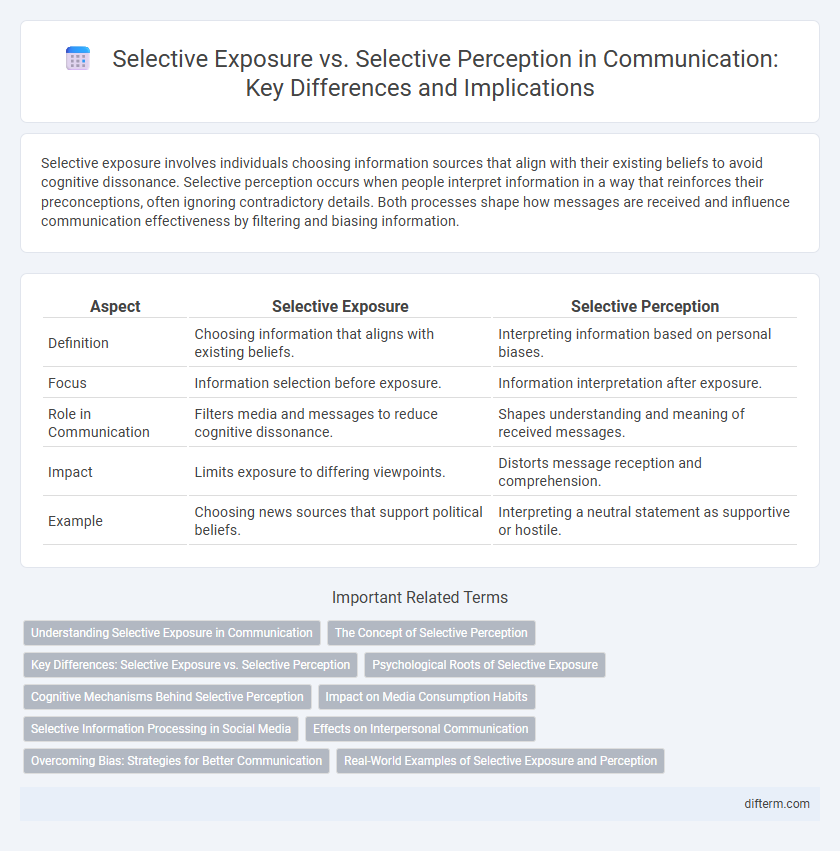Selective exposure involves individuals choosing information sources that align with their existing beliefs to avoid cognitive dissonance. Selective perception occurs when people interpret information in a way that reinforces their preconceptions, often ignoring contradictory details. Both processes shape how messages are received and influence communication effectiveness by filtering and biasing information.
Table of Comparison
| Aspect | Selective Exposure | Selective Perception |
|---|---|---|
| Definition | Choosing information that aligns with existing beliefs. | Interpreting information based on personal biases. |
| Focus | Information selection before exposure. | Information interpretation after exposure. |
| Role in Communication | Filters media and messages to reduce cognitive dissonance. | Shapes understanding and meaning of received messages. |
| Impact | Limits exposure to differing viewpoints. | Distorts message reception and comprehension. |
| Example | Choosing news sources that support political beliefs. | Interpreting a neutral statement as supportive or hostile. |
Understanding Selective Exposure in Communication
Selective exposure in communication involves individuals actively choosing information sources that align with their preexisting beliefs, enhancing message relevance and reducing cognitive dissonance. This behavior affects information processing by limiting exposure to diverse viewpoints, thereby reinforcing personal biases and shaping communication outcomes. Understanding selective exposure helps in designing targeted communication strategies that acknowledge audience preferences and encourage more open information exchange.
The Concept of Selective Perception
Selective perception is a cognitive process where individuals interpret information in a way that aligns with their preexisting beliefs and attitudes, filtering out contradictory messages. This phenomenon influences communication by shaping how messages are received and understood, often reinforcing existing biases. Understanding selective perception helps in designing communication strategies that account for audience predispositions and improve message effectiveness.
Key Differences: Selective Exposure vs. Selective Perception
Selective exposure involves individuals actively choosing information sources that align with their existing beliefs, thereby avoiding contradictory messages. In contrast, selective perception refers to the cognitive process where people interpret and filter received information in a way that reinforces their preconceived notions. The key difference lies in selective exposure being a choice of information intake, while selective perception shapes how that information is processed and understood.
Psychological Roots of Selective Exposure
Selective exposure originates from cognitive dissonance theory, where individuals avoid information conflicting with their existing beliefs to reduce psychological discomfort. This bias is driven by the need for cognitive consistency and emotional stability, prompting people to seek media and messages aligning with their attitudes. The psychological roots of selective exposure highlight the role of motivated reasoning in shaping how audiences consume information.
Cognitive Mechanisms Behind Selective Perception
Selective perception stems from cognitive mechanisms where individuals filter and interpret information based on existing beliefs, schemas, and expectations, reinforcing their worldview. This process involves attention bias, memory recall aligned with preconceived notions, and interpretative frameworks shaped by prior experiences. Such cognitive filtering contrasts with selective exposure, which centers more on the active choice to encounter compatible information sources.
Impact on Media Consumption Habits
Selective exposure drives individuals to seek out media that align with their preexisting beliefs, reinforcing confirmation bias and creating echo chambers. Selective perception influences how media messages are interpreted, leading audiences to filter information through their cognitive biases and personal experiences. Together, these processes shape media consumption habits by limiting exposure to diverse viewpoints and promoting information that supports existing attitudes.
Selective Information Processing in Social Media
Selective information processing on social media involves individuals filtering content that aligns with their existing beliefs, reinforcing confirmation bias by selectively exposing themselves to certain information while interpreting ambiguous messages in a biased manner. Algorithms amplify this effect by curating feeds that prioritize familiar viewpoints, which intensifies echo chambers and polarization within online communities. Understanding these mechanisms is crucial for addressing misinformation and promoting more balanced communication in digital environments.
Effects on Interpersonal Communication
Selective exposure limits interpersonal communication by causing individuals to favor information that aligns with their existing beliefs, thereby reducing openness to diverse perspectives. Selective perception further distorts communication by filtering messages through personal biases, leading to misunderstandings and misinterpretations. Both processes contribute to communication barriers, reinforcing echo chambers and hindering effective dialogue.
Overcoming Bias: Strategies for Better Communication
Overcoming bias in communication requires recognizing the differences between selective exposure, where individuals prefer information aligning with their beliefs, and selective perception, which involves interpreting information to fit existing attitudes. Strategies such as active listening, seeking diverse perspectives, and promoting open dialogue help mitigate these biases, fostering clearer and more effective communication. Implementing these techniques enhances understanding and reduces misinterpretations in both personal and professional interactions.
Real-World Examples of Selective Exposure and Perception
Selective exposure occurs when individuals choose media sources that align with their existing beliefs, such as someone only following news outlets that support their political views. Selective perception involves interpreting ambiguous information in a way that confirms one's preconceptions, like a sports fan viewing a referee's call as unfair only when it goes against their team. Real-world examples include social media algorithms reinforcing selective exposure by curating similar content and eyewitnesses recalling events differently due to selective perception biases.
selective exposure vs selective perception Infographic

 difterm.com
difterm.com